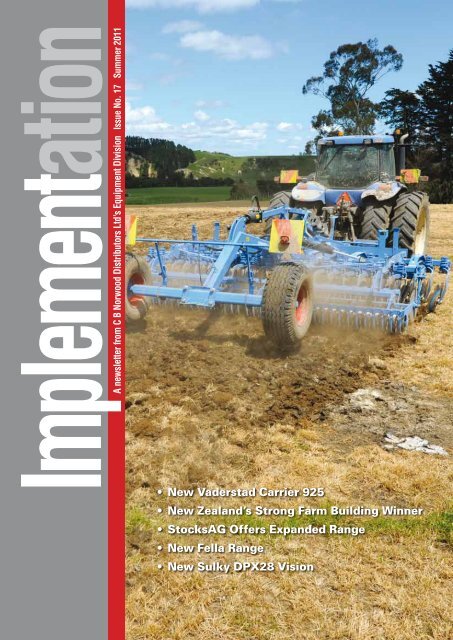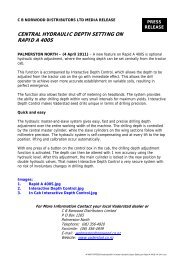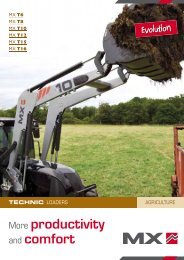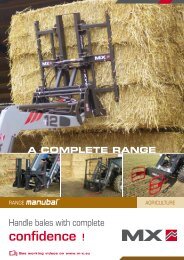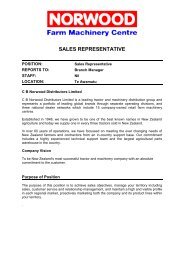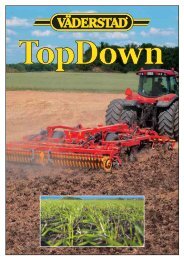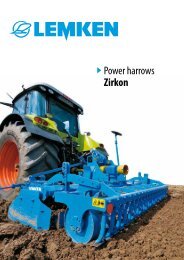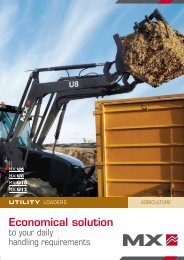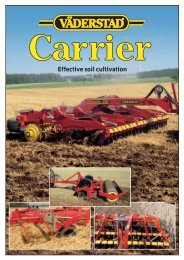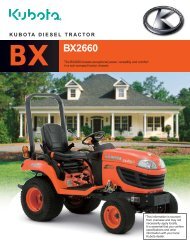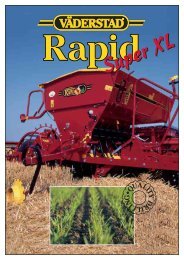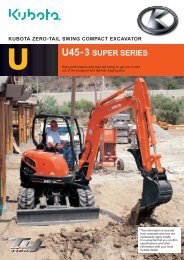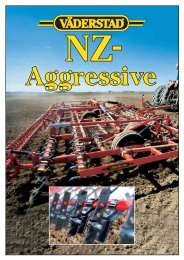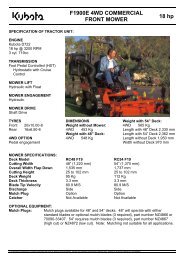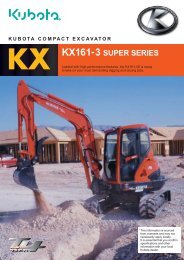• New Vaderstad Carrier 925 • New Zealand's Strong ... - LiveUpdater
• New Vaderstad Carrier 925 • New Zealand's Strong ... - LiveUpdater
• New Vaderstad Carrier 925 • New Zealand's Strong ... - LiveUpdater
Create successful ePaper yourself
Turn your PDF publications into a flip-book with our unique Google optimized e-Paper software.
Implementation<br />
A newsletter from C B Norwood Distributors Ltd’s Equipment Division Issue No. 17 Summer 2011<br />
• <strong>New</strong> <strong>Vaderstad</strong> <strong>Carrier</strong> <strong>925</strong><br />
• <strong>New</strong> Zealand’s <strong>Strong</strong> Farm Building Winner<br />
• StocksAG Offers Expanded Range<br />
• <strong>New</strong> Fella Range<br />
• <strong>New</strong> Sulky DPX28 Vision
PRODUCT NEWS<br />
<strong>Vaderstad</strong> <strong>Carrier</strong> <strong>925</strong> –<br />
Seedbed preparation on a broad front<br />
The <strong>Vaderstad</strong> <strong>Carrier</strong> <strong>925</strong> is the most powerful model in the<br />
<strong>Carrier</strong> series, with impressive capacity. With integral Crossboard<br />
and 135 kg weight per disc, <strong>Carrier</strong> <strong>925</strong> is equipped to<br />
crush, pulverise and level heavy furrows or efficiently slice<br />
and incorporate stubble. <strong>Carrier</strong> <strong>925</strong> saves passes in seedbed<br />
preparation!<br />
The <strong>Carrier</strong> has one of the highest disc pressures on the<br />
market, which gives impressive capacity in hard, dry conditions.<br />
Special steel tines<br />
The carrier with Crossboard is suitable in systems where<br />
ploughing and ploughless tillage are both used. This is an implement<br />
that gets the job done, irrespective of crop rotation,<br />
weather or soil conditions. Crossboard consists of a number<br />
of spring tines of special steel that aggressively crush coarse<br />
furrows. The tip of the Crossboard tine consists of an angled<br />
wearing plate that can be replaced if necessary. The Crossboard<br />
tines are connected together by a stabiliser bar made of<br />
spring steel with a fracture point of over 1100 N/mm 2 .<br />
Electric depth stop<br />
Fast and easy: <strong>Carrier</strong> <strong>925</strong> is equipped with an electric depth<br />
stop which means that the toolbar returns to the pre-set depth<br />
when it is lowered again e.g. after turning on headlands.<br />
All easily done from the cab<br />
The working depth of the discs and the angle of attack of<br />
Crossboard can both be hydraulically adjusted on the go from<br />
the tractor cab. During stubble cultivation, Crossboard can be<br />
folded up completely.<br />
Steel roller crushes and consolidates<br />
The steel roller made from press-hardened steel has enormous<br />
resistance to wear and presses down soil and crop trash with<br />
all its force. The shape of the roller rings means that they do<br />
not simply work the surface but also aggressively crush and<br />
press plant residues into the soil.
CUSTOMER NEWS<br />
Win <strong>New</strong> Zealand’s <strong>Strong</strong>est Farm Building<br />
winner announced<br />
<strong>New</strong> Holland, Fella, Lemken, JFStoll, <strong>Vaderstad</strong> and their dealers<br />
ran a nationwide customer competition during the month<br />
of June 2010 to ‘Win <strong>New</strong> Zealand’s <strong>Strong</strong>est Farm Building’.<br />
The <strong>Strong</strong>Built 3-bay lean-to supplied by GoldPine was<br />
successfully used as the National Fieldays ® headquarters for<br />
the <strong>New</strong> Holland and Norwood Agricultural Equipment teams<br />
during June.<br />
Taranaki contractor Jason Holdem was absolutely rapt when<br />
his local dealer, Mark Sanger of Norwood Farm Machinery Centre<br />
in Hawera popped in to tell him he had won a shed. Earlier<br />
that week Jason had asked “have I won my shed yet”!<br />
Jason is a long-time customer who owns several <strong>New</strong> Holland<br />
tractors, Fella mowers, tedders and swathers and most<br />
recently a <strong>Vaderstad</strong> drill. He runs Holdem Contracting Limited<br />
from his home in Hawera, specialising in round and square hay<br />
and silage bales and direct drilling.<br />
Jason says the Fella equipment in his fleet is a critical part<br />
of his operation. For the past seven years Jason has owned<br />
and operated two 3.1m wide Fella SM310 Trans mowers which<br />
fold up to a narrow transport width to allow for easy farm gate<br />
access. “They’ve treated us well. The guys that operate them<br />
like operating them and they suit our system,” Jason says.<br />
Jason has also owned a Fella 5.5 metre Hydro 540 tedder<br />
for three years. He says it is an easy-to-use tool that does a<br />
good job and people comment on the good job it does. “It<br />
throws the crop out well and spreads it easily. It’s a good reliable<br />
tool and hasn’t given us any trouble.”<br />
In addition, Holdem Contracting operates a 6.7m Fella 671<br />
swather, and an 8m Fella 801 swather. “The 671 is seven years<br />
old and was bought with one of the mowers, and the 801 is<br />
three years old,” Jason says. “They’re pretty similar machines,<br />
are easy to use and we like the way they contour the ground.”<br />
Jason says it is particularly easy to adjust the working width<br />
of the swathers. “They are a good basic machine and, like the<br />
mowers, they have treated us well and haven’t given us any<br />
problems.”<br />
The draw was conducted by a Palmerston North Police Officer<br />
at the Head Office of C B Norwood Distributors Ltd.<br />
From left: Paul Southgate (Norwood Agriculture Equipment);<br />
Jason Holdem (Holdem Contracting), Mark Sanger (Norwood Farm Machinery<br />
Centre, Hawera) and Geoff Taylor (GoldPine)
CUSTOMER PROFILE<br />
Dairy farmers sold on JF-Stoll technology<br />
Waikato dairy farmer George Campbell made the switch to a<br />
JF-Stoll mixer wagon last year due to its reputation as a strong<br />
and versatile feeder, with superior mixing capabilities. George<br />
and his father Mark Campbell run a 153-hectare dairy farm and<br />
a 200-hectare run off at Korakonui, south of Te Awamutu. They<br />
milk 680 cows and winter a further 140.<br />
They purchased the JF-Stoll VM22-2 mixer wagon over a<br />
year ago from Norwood Farm Machinery Centre, Te Awamutu<br />
to replace the horizontal wagon they were previously using.<br />
George says the change was made to the JF-Stoll wagon with<br />
vertical mixers for a number of reasons, including its lower<br />
horsepower requirement. “I was given a good demonstration<br />
with the machine. I had it fully explained to me and I was given<br />
a good deal trading in my previous mixer wagon,” he says.<br />
“The vertical wagons are more versatile than the horizontal<br />
wagons, and bridging was a bit of an issue in the horizontal<br />
wagon. The JF-Stoll also has less moving parts than the other<br />
machine. They operate quite differently.”<br />
George uses the wagon every day, mixing a diet of grass,<br />
maize silage, palm kernel and triticale. “Later on we’re going to<br />
start using lucerne. I’ve put molasses in the back and it mixes<br />
through the whole lot. You put the minerals in through a side<br />
door and it also mixes well. I can now guarantee production<br />
with the changing seasons.”<br />
JF-Stoll’s VM22-2 mixer wagon has a 22m 3 volume and<br />
a tractor requirement of 115hp. The conical construction of<br />
the tub means low power consumption. Its unique high-speed<br />
mixing auger with short knives is capable of shredding large<br />
amounts of straw, with long tungsten-coated knives also available.<br />
George finds the JF-Stoll VM22-2 easy to use. He particularly<br />
likes the remote scales and says they are easy to read<br />
and use to get the weight right. All JF-Stoll VM feeders are<br />
equipped with the wireless weighing system Feed Manager,<br />
which can be moved around by the operator for convenience<br />
and comfort. The feeder can be loaded from all sides, including<br />
the rear, because the weight information is in the loader tractor.<br />
The Feed Manager saves time in loading, travelling and feeding<br />
out.<br />
“The wagon is modular and can be modified. If you increase<br />
your herd you can add hungry sides or top to increase the capacity,”<br />
George says. The JF-Stoll VM22-2 is made of high-strength<br />
steel for greater longevity and reduced wear. “The drive shafts<br />
go through the first auger and then the second. There are no<br />
right angles, which means less greasing,” George says.
FORAGE CONSERVATION FEATURE<br />
From field to feed<br />
In order to make the best quality silage there are five key rules<br />
that must be observed: cut grass early, cut grass dry, ensure<br />
speed of ensiling, ensure pressure in silage clamp, and ensure<br />
air tightness of the silage clamp.<br />
Cut early<br />
Early cutting means that you get the best quality of grass, with<br />
the highest digestibility and many tests have shown that with<br />
later cutting the overall bulk of material may increase but the<br />
resulting digestibility of the crop decreases.<br />
Therefore, the use of your own machinery, or getting a<br />
contractor when you require one, is very important as this will<br />
enable you to cut the crop at the ideal time, giving you the<br />
chance to maximise the quality of the silage made.<br />
Cutting dry grass can be sometimes easier said than done.<br />
Normally grass contains approximately 85% water when it is<br />
cut, or 15% dry matter. This, if possible, should then be dried<br />
by a combination of wind and sun to a dry matter content<br />
of approximately 30% as soon as possible, in order to avoid<br />
loss of nutrients from the grass. Conditioning, wide spreading<br />
or tedding can be used to assist this rapid drying process.<br />
Speed of ensiling<br />
The goal of silage making is to convert sugar into lactic acid<br />
and to preserve the grass for the animals. Speed is important,<br />
as once the grass is cut it starts to deteriorate, and with the<br />
risk of wet weather, speed of ensiling can ensure that all the<br />
grass is ensiled before the rain arrives. Tests have shown that<br />
10mm of rain can wash 10% of the sugars out of the grass,<br />
which then reduces the amount of lactic acid produced when<br />
ensiled. This, in turn, will have an effect on the fermentation<br />
process. Speed is also important as grass can start to heat<br />
when mowed as the energy used to produce the heat comes<br />
from the grass sugars. This again reduces the amount left to<br />
produce lactic acid.<br />
Pressure<br />
Pressure is required to expel any air from the grass as it is<br />
ensiled to avoid any air pockets. This is achieved by compression<br />
from the buck raking machine and skilful filling of the silo<br />
in layers to avoid air pockets. Pressure is easier to apply to<br />
shorter cut material as the compaction will travel deeper into<br />
the clamp, compressing the material more. Expelling more air<br />
will enable the silo to hold an increased volume of material<br />
into a given space.<br />
Air tightness<br />
Air tightness is required to ensure that no air can enter the silo.<br />
When air enters the silo, a process will begin the production of<br />
butyric acid. This is produced by butyric acid bacteria (chlostridium),<br />
which can live on almost anything. Their waste product<br />
is not wanted as it has a strong odour and grass in a silo will be<br />
decomposed into compost if the air is changed 55 times. This<br />
often happens with a loose silo top acting like a lung, pumping<br />
oxygen down into the silage. Wilting, and the avoidance of soil<br />
and manure in the grass, will also assist with the reduction of<br />
butyric acid production.<br />
Stationary knives or precision cut<br />
It used to be said that chopping should only be done out of<br />
consideration for the mechanization of the feeding process<br />
and not out of consideration of the cow. This attitude has now<br />
changed, partly because it is important for the compression<br />
of the silo and thus the silage quality, and partly because it is<br />
necessary in order to manufacture quality feed in conjunction<br />
with complete diet mixers.<br />
Therefore, today, it is important how the grass is cut or<br />
chopped. A slow moving cut against stationary knives can result<br />
in there not being any sap at the outer surfaces of the<br />
grass and it will take longer before the lactic acid bacteria get<br />
into contact with the sugar in the grass and starts the ensiling<br />
process.<br />
It is different with any high speed rotating chopper which<br />
crushes the grass when chopping it and smears the sap out on<br />
to the grass surface. A test carried out at the Royal Veterinary<br />
and Agricultural University of Denmark comparing these two<br />
cutting/chopping methods confirms that these assumptions<br />
are correct.<br />
Why precision chop?<br />
The grass sap and possible additives will be evenly distributed<br />
on all surfaces. The process of ensiling starts earlier and the<br />
quality is better. Often the surface of the grass is dry and the<br />
bottom wet. The precision chop forage harvester will mix top<br />
and bottom so that ensiling material will be completely mixed<br />
up. In this way you avoid mildew spots in the silage, thus achieving<br />
less bad quality and less wastage. Precision chop silage is<br />
more uniform in chop length than cut grass, as the percentage<br />
of grass cut within a small tolerance of the set theoretical chop<br />
length is much greater than with cut grass. This helps to avoid<br />
mildew spots and bad quality silage in the silage clamp.<br />
When the crop has been precision chopped it is easier to<br />
compress to a higher density. Furthermore the cubic content<br />
of the silo will be better utilised. The feeding out of the silage<br />
is easier to mechanise so that total mixed ration can easily be<br />
carried out.<br />
Written by Frank Ward, JF-STOLL Ireland<br />
Guide to Basic Settings for Mowers<br />
JF-Stoll has created a guide which can help the customers optimize<br />
the capacity of their JF-Stoll mower. The guide shows the<br />
basic settings on JF-STOLL mowers for operation under normal<br />
conditions. Subsequently the settings can be adjusted and optimized<br />
according to local and regional conditions, since the nature of<br />
the crop and the ground conditions always influence the working<br />
capacity of the machine.<br />
The guide can be downloaded from the website www.jfstoll.co.nz
CUSTOMER PROFILE<br />
Lemken Zirkon takes a bite out of work times<br />
Contractor Thomas Kershaw says his new Lemken Zirkon<br />
10/500 power harrow has helped speed up his ag work considerably.<br />
Thomas bought the Lemken Zirkon 10/500 power<br />
harrow in July for his business, T Kershaw Contracting, which<br />
operates in the south Wairarapa.<br />
The use of power harrows is gaining increasing importance<br />
in some districts. Using one in combination with other implements<br />
means several tasks can be done faster and cheaper.<br />
“We opted for the trapeze roller on the Lemken Zirkon, as in<br />
the wet soil conditions it doesn’t block up – it keeps rolling,”<br />
Thomas says. “We do a lot of onion bulbs. With packer rollers<br />
in the winter in the wetter conditions we were always stopping<br />
and scraping them, or waiting until it was drier. The trapeze<br />
roller is a big one and is a Lemken factory fit.”<br />
The Lemken Zirkon harrow has an intensive mixing and<br />
crumbling effect up to 15cm working depth. The active tools<br />
prepare an optimal seedbed in almost all soil conditions, including<br />
hard, dry and heavy soils, as well as in soils with very<br />
compact layers.<br />
Thomas looked at a variety of power harrows before choosing<br />
the Lemken Zirkon and was impressed with what Norwood<br />
Farm Machinery Centre, Masterton had to offer. “I’ve dealt<br />
with them a lot and the power harrow looked like quite a good<br />
strong build. We looked at quite a few different brands and<br />
this one was stand out. It had a lot more options and things<br />
we could do that the others didn’t have,” he says.<br />
“The tine length is quite long, which I like, and it has the<br />
option further down the track of mounting a Lemken Solitair<br />
drill straight on top of the power harrow or converting to trailing.<br />
We’re looking at that as it would mean less passes,” he<br />
says.<br />
The Lemken Zirkon power harrows meet the high requirements<br />
of modern farming business. They are suitable for<br />
continuous operation in conventional and minimum tillage seeding<br />
procedures and can be applied in front as well as in rear<br />
mounting.<br />
You can adjust working intensity by changing your driving<br />
speed, or the Zirkon’s PTO speed or gearbox setting. This means<br />
you can prepare a seedbed in only one operation.<br />
Thomas has already done about 50-60 hectares with his<br />
new Lemken Zirkon. After ploughing pea paddocks, he has<br />
gone in directly with the power harrow. “It does more than a<br />
good enough job,” he says.<br />
Dual-Shift transmission means an easy change of the rotational<br />
direction of the all-round cutter tines. “You can reverse<br />
the rotation of the tines nice and easily – you just have to undo<br />
three bolts and move the gearbox to the side – and you can<br />
adjust the gearbox speed quite easily via a lever on the side of<br />
the main gearbox.”<br />
The Lemken Zirkon 10/500 power harrow is also low on<br />
maintenance and easy to grease. The 10/500 has a closed<br />
transmission tub with a thick-walled underside of the gearbox<br />
for maximum stability, while the rotor shaft and tine carriers<br />
are forged in one piece and highly hardened.
PRODUCT NEWS<br />
StockAG offers expanded range<br />
StocksAG are pleased to add the Turbo Jet 10 outlet<br />
model for use in high rate and/or wide machine<br />
applications to the already popular eight outlet Turbo<br />
Jet model.<br />
Turbo Jet pneumatic seeders are versatile<br />
and accurate with the ability to meter and spread<br />
most small seeds up to 8 metres wide. Suitable<br />
for attachment to cultivation equipment of all types<br />
such as grass harrows, stubble cultivators, rollers<br />
and short discs etc for one pass seeding. Ideally<br />
suited to folding or rigid equipment, Turbo Jet<br />
will work up to 30 metres from the 12 volt power<br />
source.<br />
The versatile Turbo Jet can be used for<br />
broadcasting or band sowing from the 8 or 10<br />
outlets and can be doubled to 16 or 20 for the<br />
ultimate broadcast effect, or individually blanked<br />
off to band sow.<br />
The powerful 12 volt motor drives fluted feed<br />
rollers that meter seeds into the individual air tubes.<br />
High capacity electric fans ensure a reliable spread,<br />
and the versatile feed mechanism easily adapts<br />
for different rates and products, and a selectable<br />
agitator prevents difficult grass seeds from bridging.<br />
Available in either the simple, low cost Vari-Speed<br />
manual dial control configuration or the sophisticated<br />
Wizard radar based speed related control system<br />
to automatically maintain the application rate in<br />
proportion to forward speed changes. Both systems<br />
allow application rates to be changed on-the-move.<br />
The Wizard system effectively offers the<br />
sophistication and high accuracy of a large system<br />
drill in a compact and highly flexible unit.<br />
High capacity feed rollers are supplied to<br />
accurately meter grass at full reseeding rates up<br />
to 40 kgs/hectare at 6m wide and 12 kph. Other<br />
seeds such as clover, mustard, turnips and forage<br />
brassicas etc can be sown at very low rates down<br />
to below 2 kgs/hectare.<br />
The large 240 litre capacity hopper holds 85 kg of<br />
grass seed and has a powerful agitator driven by its<br />
own electric motor to prevent grass seed bridging.<br />
Broadcasters<br />
The Fan Jet series of broadcasters has been further<br />
enhanced with the addition of the Fan Jet Pro and<br />
Mini 240. All Fan Jets are available in the formats<br />
‘Pro’ and ‘Mini’, and whilst the well proven Pro<br />
series offers all the benefits of a compact spreader<br />
for grass seed to slug pellets, the Mini series offers<br />
a far greater control of spread width and accurate<br />
metering of the product.<br />
The combination of variable disc speed and<br />
adjustable deflectors make the Fan Jet Mini the<br />
perfect tool for the application of clover behind<br />
a drill.
PRODUCT NEWS<br />
<strong>New</strong> to the Fella range this season is an innovative<br />
line-up of mowers, tedders and rakes<br />
Having now proven themselves over a number of years in <strong>New</strong><br />
Zealand, Fella disc mowers are designed to handle the most<br />
difficult conditions. In doing so they deliver a precise cut and<br />
high forage flow without blockage and deposit the crop in consistent<br />
swaths ideal for wilting and optimum nutrient retention.<br />
Available for both rear and front mounting and also with<br />
separate transport chassis for high output and durable operation<br />
in all conditions, the large diameter disc mowers meet the<br />
demands for higher output and reliability from both farmers and<br />
contractors. The Fella range of mowers offer a long working life<br />
and economic efficiency with traditional German quality built<br />
in as standard.<br />
The new range of ISL mowers is designed specifically for<br />
farmers who are looking for a quality machine to undertake<br />
their own mowing and consist of a redesigned cutterbar assembly<br />
with Top Drive and therefore no inner skid for easy<br />
and blockage free operation. Available in three cutting widths<br />
of 2.4, 2.8 and 3.2 metres, the ISL range presents a value for<br />
money quality product.<br />
Large farmers and contractors will appreciate the design<br />
features incorporated into the new range of Fella heavy duty<br />
bar type and pendulum suspended mowers.<br />
Based on the well-proven and reliable hexagonal drive modular<br />
cutterbar design used by Fella for many years the new<br />
mowers the new TL range of pendulum suspended mowers<br />
are available in cutting widths of 3.0, 3.5 and 4.0 metres respectively.<br />
The fully shaft driven cutterbar is supported at each<br />
end by a bridge assembly mounted on a hydro-pneumatically<br />
suspended arm for optimum contour following and finish with<br />
the ability to adjust the suspension pressure to suit undulating<br />
conditions.<br />
The TL mower range folds to the rear of the tractor for<br />
transport and is controlled by a large hydraulic ram which also<br />
serves as the breakout protection device. The SM3060 TL,<br />
SM3570 TL and SM4080 TL are designed to be operated without<br />
a conditioner system and should a conditioner be required<br />
then the existing heavy duty SM310 TL range can be fitted<br />
with either a finger or roller conditioner.<br />
In addition the four drum KM series of mowers are available<br />
both in rear and front mount for those who prefer the features<br />
of a drum mower and the benefits presented thereby.<br />
The popular Fella range of TH tedders continues to be developed<br />
and is further enhanced with the addition of the larger<br />
semi-trailed machines designed specifically with the large scale<br />
hay and silage contractor in mind. Based on a heavy duty transport<br />
chassis the TH Trans range is now available in working<br />
widths of 8.6, through 10.2 to 12.8 metres.<br />
All machines fold to within 3.0 metres for transport and in<br />
doing so the weight is transferred and shared between the<br />
tractor’s rear linkage and the transport wheels.<br />
All TH tedders share the same unique features such as<br />
auto rotor shut off on folding and easily adjustable pitch and<br />
offsetting control for optimum swath management.<br />
The extremely popular range of Fella swather rakes is also<br />
enhanced for the coming season with the addition of the exciting<br />
new TS10055 two rotor swather. Designed specifically<br />
with the professional contractor in mind the TS10055 has a<br />
swath raking ability from 8.8 up to 10 metres and is the ideal<br />
complement to high output balers etc.<br />
Two large diameter heavy duty rotor heads carry 15 tine<br />
arms per rotor, each of which forms a rotor diameter of 4.2<br />
metres. A swath width of between 1.2 and 2.2 metres can be<br />
produced and this is easily adjustable hydraulically from the<br />
tractor cab.<br />
Tines are mounted in pairs of four per arm and the timing of<br />
which can be set to one of five positions to produce the perfect<br />
swath profile for optimum bale fill.<br />
Transmission to each rotor from the PTO is via a wide angle<br />
PTO shaft feeding a double output gearbox mounted at the<br />
front of the machine and from there to a right angle gearbox<br />
via overrun clutches on each rotor.<br />
Each rotor is supported by a ground contouring chassis<br />
which is carried by two castor wheels at the front with the<br />
option of a pair of tandem bogies at the rear. The wheels are<br />
easily adjustable for height to enable levelling of each rotor and<br />
therefore provide the ultimate in clean swath collection.<br />
The TS10055 shares all of the well proven features for<br />
which Fella has become renowned, these being ease of use,<br />
durability and quality of work; just ask anybody who runs one!
FOCUS ON PARTS & SERVICE<br />
GENUINE<br />
FELLA tines –<br />
guaranteed<br />
high quality<br />
The Point of difference between GENUINE Fella and an aftermarket tine is the<br />
process of manufacturing that Fella apply to make sure what is being supplied<br />
is guaranteed to the highest quality.<br />
The Manufacturing difference:<br />
One important step that Fella apply to their genuine tines that the aftermarket<br />
companies do not is that Fella cannonade the tine with small metal balls (similar<br />
to sand blasting). This process closes the small cracks in the material to avoid<br />
rust and cracks which can cause the tine to break.<br />
Fella have gone through an extensive testing programme on their Fella tines and<br />
also a range of different tines on their “tine-tester”,<br />
which you can see here.<br />
The lifetime of the “best” aftermarket tine was only<br />
10% of the original FELLA-tine, which means the<br />
price of an aftermarket tine would need to be less<br />
than 10% of the Fella tine to be financially beneficial<br />
over seasons.<br />
See your local Fella dealer today for your Genuine<br />
FELLA Tines!!<br />
PARTS & ACCESSORIES<br />
Superior Design<br />
is Superior Quality<br />
The perfect disc has a well-balanced combination of properties<br />
such as hardness and elasticity. If the material is too hard, the<br />
disc is brittle and prone to fracture, while if it is too elastic it<br />
wears rapidly. All Väderstad front tool and drill discs are now<br />
manufactured from special hardened steel in a process that<br />
does not compromise their elasticity. Väderstad has named<br />
this material V-55, where 55 is the HRC or Rockwell number,<br />
which is a measure of hardness. Conventional hardened<br />
wearing parts normally have a hardness of 47-48 HRC. In<br />
laboratory and field trials, the material in V-55 has been shown<br />
to increase the lifetime of the discs by up to 50% compared<br />
with the type of steel used previously.<br />
Come see your local <strong>Vaderstad</strong> dealer today for more<br />
information.
CUSTOMER PROFILE<br />
Heavy soils no burden for Horsch drill<br />
North Otago farmer John Foley’s Horsch Pronto DC4 is built<br />
tough enough to cope with the region’s heavy soils and it’s<br />
reducing the workload on his large cropping operation. John<br />
farms a 380-hectare cropping and winter calf grazing property<br />
in North Otago. He also leases a further 400-hectare cropping<br />
and livestock operation and has a share in an 840-hectare dairy<br />
farm.<br />
John purchased his Horsch Pronto drill three years ago<br />
from Norwood Farm Machinery Centre, Mosgiel. It is the first<br />
Horsch drill he’s owned, having previously used Cross Slot<br />
drills. “We looked at the Horsch because it offered versatility,”<br />
he says. “We have to plant such a large area in the spring and<br />
the 4.0m Horsch gave us the ability to up the work rate without<br />
requiring such large horsepower.”<br />
John’s cropping operation is almost fully irrigated, which<br />
also suits the Horsch better. “We researched a lot of drills. The<br />
Horsch has the best technology around and is very well made.<br />
The quality of the workmanship of the machine is excellent and<br />
I like the relative simplicity.”<br />
The Horsch offers John a three-in-one operation, with the<br />
front turbo discs followed by the roller and drill. “At times we<br />
don’t use the disc but we have found it very good with pugging<br />
after cows. It’s phenomenal,” he says. “It’s a one-pass machine.<br />
We have direct drilled but we usually go into the ground<br />
first with a disc type incorporator and follow it up with the drill.”<br />
John and his team operate on 24m tramlines and the Pronto<br />
DC4 is highly effective at sowing seeds ranging from clover<br />
to rape and grains such as wheat and barley. One of the benefits<br />
of using the Pronto is the accuracy of seed placement<br />
and the Horsch double disc coulter helps to achieve excellent<br />
penetration. Also, the fact that the depth-setting press wheel<br />
is just 45cm behind the coulter ensures very accurate contour<br />
following. This is a major advantage over drills with a larger gap<br />
(up to 110cm).<br />
The full width tyre packer, which runs behind the front cultivation<br />
discs and in front of the drilling coulters, is another key<br />
design feature. As well as enabling operators to optimise the<br />
efficiency and working depth of the cultivation discs, the packer<br />
firms the seedbed ahead of the drilling coulters, eliminating<br />
coulter disc stalling, which can be a problem for disc drills<br />
working in un-consolidated soil.<br />
“The fertiliser location is another real bonus,” John says.<br />
“It’s been a very good all-round machine and the calibration is<br />
so simple – there’s never a problem.”<br />
John says while a lot of machinery doesn’t suit North Otago’s<br />
heavy soils, the Horsch Pronto copes well on his farm’s<br />
heavy undulating country. Maintenance has also been low on<br />
the machine, which does about 800 hectares a year. “We do<br />
contracting work with it when it’s not working for us and it’s<br />
stood the test of time.” The Pronto DC is renowned for easy<br />
maintenance of the drilling coulters themselves, with the replacement<br />
of worn parts being a quick, simple job.
PRODUCT NEWS<br />
More than 25 Years of Horsch Innovation<br />
Company founder Michael Horsch and his brother Philipp made<br />
clear why Horsch Maschinen GmbH was able to grow so rapidly<br />
over the last 25 years, because both of them have an<br />
unlimited passion for agriculture.<br />
Being the oldest of six siblings Michael Horsch went<br />
to the USA in 1979 after his journeyman’s examination to<br />
have his own farm over there one day. But he had to return<br />
to Germany to do his non-military service. At the back<br />
of his mind he fiddled about with direct seed drills. At the<br />
same time his uncle Helmut Horsch challenged him to further<br />
develop a new technology in growing maize under foil.<br />
Within a few weeks Michael had developed the prototype<br />
and received follow-up jobs from the big family. Parallel to that<br />
the first direct seed drill came to life. For a long time the Sä-<br />
Exaktor (Seed Exactor) would be the bread and butter machine.<br />
In 1984 Michael Horsch, his father Dankwart and Walter<br />
Horsch founded Horsch Maschinen GmbH as chief partners.<br />
Walter and Michael Horsch became directors. Soon other products<br />
were developed: The Terra-Trac became an important<br />
mainstay of sales. With this three-wheel tractor, first designed<br />
as a self-propelled seeding machine, Horsch became more<br />
known. In France, Michael Horsch met his wife Cornelia - her<br />
father was one of the first Horsch clients.<br />
Late 2009 Horsch celebrated 25 years by presenting<br />
themselves on the largest stand in the company’s history at<br />
the Agritechnica show which, this year, has been the second<br />
largest German show after the IAA. On about 2000 m² 16<br />
machines were shown – including seed drills, cultivators and<br />
machines for transport logistics.<br />
On display were the 3-point seed drill Express 3 TD, the<br />
updated Terrano FX cultivator series, the universal seed drill<br />
Pronto 6 KR with rotary harrow, the universal seed drill Pronto<br />
12 DC for large fields with a seed wagon hopper capacity of<br />
17,000 litres, the tine seed drill Sprinter 8 SW and, of course,<br />
the new Horsch auger waggon Titan 34 UW.<br />
The auger waggon with a hopper capacity of 34m³ was<br />
one of the highlights on the stand due to its sheer dimension.<br />
Concerning the output, it also stands for harvest efficiency in a<br />
new dimension. Due to the large hopper capacity of 34 m³ idle<br />
times on the field boundaries and awkward manoeuvring are<br />
part of the past. The hopper capacity of the UW corresponds<br />
to one truckload. A truck is thus filled at one go. The output of<br />
the newly designed hydraulically foldable auger conveyor (ø<br />
600 mm) is 18 tons per minute. Thus, 34 m³ are reloaded in<br />
only 90 seconds.<br />
The universal cultivator Terrano FX has been influenced by<br />
the know-how derived from the Tiger models. The frame has<br />
been reinforced and it has been equipped with TerraGrip tines<br />
of the second generation. Thus, Horsch makes allowance<br />
for the increasing tractor power. Moreover, with the various<br />
equipment possibilities like six different packer versions, the<br />
cultivator can be adapted ideally to any condition.<br />
The Horsch Pronto 6 KR and the Express 3 TD, Horsch,<br />
provides seeding technology to customers for whom Horsch<br />
did not have the suitable technology among their range of<br />
products. The Pronto 6 KR is a six metre rotary harrow seed<br />
drill combination with low horse power requirement and the<br />
Express 3 TD combines the precise and well-proven Pronto<br />
technology with a 3-point attachment.
CUSTOMER PROFILE<br />
Tanco Bale Shear improves dairy farm efficiency<br />
The adoption of the new Tanco Bale Shear has made a<br />
significant impact on the efficiency and ease of feeding<br />
on Sandy Bidwill’s Wairarapa dairy farm. As one of the<br />
first people in the country to appreciate the benefits of<br />
the innovative Bale Shear, Sandy has nothing but praise<br />
for the way such a simple machine has revolutionised<br />
his feeding system.<br />
Not only does the Tanco Bale Shear retain both the net<br />
and wrap as it splits a round silage bale, but the action<br />
of the knife through all of the layers of the bale means<br />
that the silage is presented to the feeder in a far more<br />
fragmented fashion. This chopping or reduction effect<br />
means that mixing or merely feeding out is far more consistent.<br />
The automatic cutting and wrap retention system<br />
completely eliminates the need for the driver to leave<br />
the tractor seat and cut and remove wrap prior to feeding,<br />
not only saving time but eliminating one of the more<br />
unpleasant jobs associated with feeding baleage.<br />
In contrast to loading and splitting bales the Bale Shear<br />
is also used as a more conventional shear grab. With<br />
the addition of two extra tines the Bale Shear is used to<br />
feed out pit silage whilst maintaining a clean waste free<br />
face in the stack.<br />
In terms of time saving alone, Sandy claims that the<br />
feeding of 1200 cows across three herds has been reduced<br />
from three hours to one.<br />
See Sandy Bidwill talking about how the Tanco Bale<br />
Shear has transformed his system at http://www.youtube.com/watch?v=2-KiOEAtVIc
PRODUCT NEWS<br />
Irish firm continues to innovate<br />
Cycle; and Automatic Load, Wrap and Tip Cycle. All three cycles<br />
are easily selected on the digital control panel. This is the ideal<br />
system for the semi-professional user requiring a fully automatic<br />
wrapping system for ease of use.<br />
An adjustable hydraulic valve allows the lowering speed<br />
of the hydraulic bale ramp to be changed for different weight<br />
silage bales. A radio remote control kit for static wrapping, an<br />
end tip ramp and wide low pressure ground tyres are optional<br />
extras.<br />
Tanco began producing light engineering products in the early<br />
1960s. Today, Tanco Autowrap produces the widest range of<br />
quality agricultural wrapping machinery in the world, exporting<br />
them to over 30 countries worldwide.<br />
Tanco Autowrap’s commitment to research and development<br />
ensures that our valued customers receive an innovative,<br />
efficient and enduring agricultural machine. That’s why<br />
Tanco Autowrap is the only choice for agricultural wrapping<br />
machines and agricultural machinery implements for many<br />
contractors and farmers across the world.<br />
Currently the Tanco round bale wrapper range includes the<br />
stationary 280 ARC, the trailed 580 S, 580 A, and 1400 EH,<br />
and the mounted 1300 S, 1300 SM, 1300 EH and 1320 EH.<br />
Tanco square bale wrappers capable of wrapping both round<br />
and square bales include the mounted 1514 S and 1514 T, the<br />
stationary 1804 S and the trailed 1814 and 404 EH.<br />
404 EH Mini Wrapper<br />
The 404 EH is the only trailed mini square and round bale<br />
wrapper on the market. It dramatically speeds up the wrapping<br />
process by independently following the baler in the<br />
field. A hydraulic squeeze arm and the unique roller configuration<br />
ensure controlled bale loading, positioning and<br />
consistent quality film overlap. The wrapper includes fully<br />
automatic electronic control, allowing operation from within<br />
the tractor cab or through the optional radio remote control.<br />
580A Round Bale Wrapper<br />
The 580 A round bale wrapper is a compact, robust machine<br />
suitable for farmers and contractors. This agricultural wrapping<br />
machine has an electronic control box mounted in the tractor<br />
cab controlling all functions of the machine automatically.<br />
The electronic controller allows for three operator cycle modes:<br />
Automatic Wrapping Cycle; Automatic Load and Wrap<br />
1300 EH Round Bale Wrapper<br />
The 1300 EH rear-linked or loader mounted round bale wrapper<br />
is robustly built, but still only weighs 655 kgs, making it suitable<br />
for most tractors and material handling machines. The wrapper<br />
includes fully automatic electronic control, allowing operation<br />
from within the tractor cab or through the remote control. High<br />
performance, low maintenance, compact size, versatile fitting<br />
and application make this agricultural wrapping machine appropriate<br />
for both farmers and contractors.<br />
The 1300 EH uses a unique wrapping system that wraps<br />
and stacks in one process - vastly reducing time, labour and<br />
equipment. Once the bale is loaded, the wrapping cycle starts<br />
immediately. Once the operator arrives at the stack, they simply<br />
drop the bale into position on the stack. A stack of round<br />
bales one to three high can be completed with this wrapper.<br />
The satellite wrapping arm allows for proficient film application<br />
that expels air from inside the wrapping sequence. The<br />
simple, but effective design of the end tip kit allows for the<br />
bale to be dropped onto its flat side when unloading.<br />
1400 EH High Speed Trailed Round Bale Wrapper<br />
The 1400 EH has a hydraulic offset hitch and loads from the<br />
front following the line of the baler (no need for crossing swathes).<br />
The loading arm is attached directly to the table frame, so<br />
when the loading arm drops to the ground, the table uniquely<br />
splits. This allows the silage bale to gently transfer from loading<br />
arm to table, greatly reducing the stress of the chassis. The<br />
loading and bale transfer is a very fast and efficient process. A<br />
unique compact design also ensures stable loading of heavy<br />
bales.<br />
The 1400 bale wrapper uses proportional speed controls<br />
enabling the operator to set wrapping speeds from the controller.<br />
The twin tower design makes the 1400 Series much<br />
stronger and capable of wrapping in all conditions. Specially<br />
designed aluminium wrap arms reduce wear and tear, ensuring<br />
a longer life for the wrapper. Automatic film break sensors<br />
come as standard. The fast acting and strong gripping cut and<br />
starts ensure short cycle times.<br />
The unique split table allows the back roller to lower independently,<br />
gently offloading a wrapped bale. As the rear<br />
roller offloads a wrapped bale, the front roller and loading arm<br />
simultaneously lower to the loading position and the next bale<br />
can be wrapped without delay. The optional end tip kit allows<br />
the bale to automatically tip over onto the flat end as the bale<br />
offloads.
PRODUCT NEWS<br />
Lemken optimises its production facility<br />
with high-tech paint coating<br />
The new cathodic dip coating facility as big as a football pitch<br />
is where LEMKEN farm machines are now given their typical<br />
blue colour. But the family business, based in the lower Rhine<br />
region, has not just put a new paint-shop into operation; at<br />
the same time it has set the signals for even more efficient<br />
production processes.<br />
LEMKEN is reacting to the increasing demand for its products<br />
as well as to the growing requirements for paint quality<br />
and top class appearance of machinery as demanded by customers.<br />
In addition, LEMKEN’s cathodic dip coating plant is<br />
particularly environmentally friendly due to its high efficiency<br />
levels, and the fact that it incorporates a modern energy-saving<br />
concept.<br />
Using a controlled current flow process, cathodic dip coating<br />
deposits the paint particles uniformly onto the surface of<br />
the machine. The paint is then fired inside a high-temperature<br />
furnace at approximately 160°C. Results are very even and<br />
the system produces very resilient surfaces and long-lasting<br />
corrosion protection. This is even achieved on complex shaped<br />
components thanks to the excellent coating properties of the<br />
cathodic dip coating method.<br />
With the innovative system, which meets the high standards<br />
of tractor and combine manufacturers, it is possible to<br />
always comply with the specified hardness parameters at a<br />
coating thickness of 45 micrometers (half the thickness of a<br />
human hair).<br />
The paint-shop, which cost 10 millon Euro, consists of a<br />
blasting plant, a 9-zone pre-treatment plant, including zinc-phosphating<br />
for improved paint adhesion, the cathodic dip area,<br />
the drying kiln, and the cooling zone. Parts are fed through the<br />
paint line on an 800 metre long “power and free” ceiling hung<br />
conveyor system.<br />
The heat recovery system installed at the same time as the<br />
cathodic dip coating system recovers waste heat and uses<br />
renewable energy to ensure that the plant is operated in an<br />
energy-saving and climate-friendly manner.<br />
The centrepiece of the integral energy concept, which also<br />
includes heating for the assembly hall and the social areas,<br />
as well as the hot water supply, is formed by the so-called<br />
energy circuits. These use heat exchangers to store heat in<br />
the interconnected energy network, for onward transmission<br />
to the consumers that require it. Auxiliary burners are used<br />
when higher temperatures are required. Thanks to this innovative<br />
interconnected energy network LEMKEN has reduced<br />
its carbon footprint by 500 tonnes of CO2 per year.<br />
Besides the particularly resilient coating and the associated<br />
increase in quality, with the installation of the cathodic dip coating<br />
plant LEMKEN has also greatly improved its production<br />
processes.<br />
The change from the previous method of assembly prior<br />
to painting, to the system of painting every component before<br />
they are assembled, means that orders are carried out to<br />
customers’ specifications, with shorter processing times and<br />
improved quality.<br />
Cathodic dipping bath<br />
The cathodic dip coating process during which the paint is<br />
applied to the component, takes place in an approximately<br />
60 cubic meter plastic bath.<br />
Niels Veltman, Export Manager for Lemken on his recent visit to <strong>New</strong> Zealand<br />
From left: Aidan Cudby, Norwood Farm Machinery Centre,<br />
Hastings; Chris Bruce, Norwood Agriculture Equipment;<br />
Garry Watt, Norwood Farm Machinery Centre, Hastings;<br />
Kevin Hermansen, Hermansen Contracting and Niels<br />
Veltman, Lemken Germany<br />
From left: Jim Alpe, Colton Bros; Niels Veltman, Lemken<br />
Germany and Rob Gawith, Colton Bros
PRODUCT NEWS<br />
Sulky DPX28 Vision WPB:<br />
Automatic Weighing Accessible To All!<br />
Automatic weighing generates indisputable savings in fertilizer<br />
use. Already in widespread use on larger farms, Sulky has now<br />
made it accessible to everyone. In September 2010 the fertilizer<br />
equipment specialist launched a series of super-equipped<br />
fertilizer spreaders, the DPX28 Vision WPB.<br />
Latest generation Vision console<br />
The application rate can be set automatically from the Vision<br />
console in the tractor cab. A 100% stainless steel cell, which is<br />
ultra-resilient (rated for 10 tonnes!), is protected on the inside<br />
of the frame; it is this that constantly supplies weight information<br />
relating to the fertilizer in the hopper.<br />
The flow shutters are controlled both hydraulically and electrically:<br />
the electric cylinders, which are very precise, control<br />
the adjustment of the application rate (electronic DPA), whilst<br />
the faster hydraulics take care of opening and closing the shutters<br />
in full, especially at the ends of the field.<br />
The Vision console is also a mine of information. Settings for<br />
eight products can be saved on it and it is also able to record<br />
data for up to 75 different plots.<br />
“Secure” working width setting<br />
The DPX28 with weighing device offers a continuously variable<br />
working width of between 12 and 28 metres. Even fertilizers<br />
with specific densities of significantly less than 1, such<br />
as granulated urea, can be spread over widths of 24 metres.<br />
Thanks to the DPX system of adjustable chutes (“continuous”<br />
adjustment of the width by adjusting the point where the fertilizer<br />
drops onto the disc); the user need not modify the discs,<br />
or the graduated spreading vanes.<br />
For border spreading, the exclusive TRIBORD device, which<br />
is controlled in-cab from the Vision console, is supplied as standard.<br />
Free access is also available to the online FERTITEST<br />
service (assistance with settings on www.sulky-burel.com).<br />
High capacity and strength<br />
Available in 1500 litres as standard but extendable to 2100<br />
litres, the DPX28 with weighing device is easy to load,<br />
especially with big bags, thanks to its 2.40 m of usable width.<br />
The anti-corrosion protection of the DPX28 with weighing<br />
device comprises 13 stages, including a full dipping by robot in<br />
a finishing bath and a final painting in three layers in compliance<br />
with the latest environmental standards.<br />
Fully equipped<br />
The standard equipment is particularly complete as it comprises,<br />
in addition to the electronic Vision WPB console, the<br />
TRIBORD remote border spreading device, a clevis linkage,<br />
external safety guard (stainless steel), integrated lighting on a<br />
stainless steel bar, and a “top of the range” transmission with<br />
torque limiter.<br />
Below: <strong>New</strong> Sulky DPX28 VISION WPB fertilizer spreader –<br />
automatic weighing accessible to all
POWER HARROWS, MULCHERS & ROTARY HOES<br />
www.breviglieri.co.nz<br />
PRECISION FINGER & VACUUM METERING PLANTERS<br />
www.kinze.co.nz<br />
MOWERS, CONDITIONERS, RAKES & TEDDERS<br />
www.fella.co.nz<br />
PLOUGHS, POWER HARROWS, CULTIVATORS & DRILLS<br />
www.lemken.co.nz<br />
FRONT END LOADERS, FRONT LINKAGES & ATTACHMENTS<br />
www.m-x.co.nz<br />
Mixer/Feeder Wagons & Forage Harvesters<br />
www.jfstoll.co.nz<br />
BALE WRAPPERS & FORAGE CONSERVATION<br />
www.tanco.co.nz<br />
TRAILED & MOUNTED FERTILISER SPREADERS<br />
www.sulky.co.nz<br />
CULTIVATORS, ROLLERS & SEEDING EQUIPMENT<br />
www.vaderstad.co.nz<br />
®<br />
®<br />
®<br />
And, finally...<br />
To keep you up-to-date with trends<br />
around the world we have invited our<br />
suppliers to comment on the market<br />
in their own country. This issue we<br />
hear from Heiner Bellstedt, Export<br />
Area Manager, Fella-Werke GmbH.<br />
Update on Agriculture in Europe<br />
“Since last autumn the mood in terms of<br />
investment is much better! The whole industry<br />
is recovering! The weather situation<br />
was reducing the grain yields all over Europe.<br />
We had a hot spring (May) and hot early<br />
summer (June until mid July), so in many<br />
places plants were short of water which was<br />
reducing yields. The main harvest month August<br />
was just the other way round; it was<br />
quite often too wet which was decreasing<br />
the quality of the crops and increasing the<br />
harvesting costs.<br />
For example in Germany the total grain<br />
harvest was down by 12% compared with<br />
last year (2010: 44 Mio to.). The mood after<br />
the harvest was much better because wheat<br />
prices were up by 40 to 50% depending on<br />
the quality! Meanwhile they increased up to<br />
250 € per ton of wheat. Rape and corn prices<br />
are up as well which is even improving<br />
the cash flow situation of the arable farmers.<br />
Prices for pork, beef and milk are not<br />
on that high level as cash crops which means<br />
that only the profitable livestock farmer<br />
earns money which they are willing to reinvest.<br />
In France we have the same situation;<br />
due to a higher price level for cereals, corn<br />
and rape arable farmers are investing in ma-<br />
chinery. Farmers want to improve the efficiency<br />
of their production by investing in<br />
modern technology in order to balance low<br />
prices in the future. Livestock farmers are<br />
still behind.<br />
In Russia the total harvest of grain went<br />
down from 62 Mio. to in 2009 to 45 Mio. to<br />
in 2010. Because of this they stopped nearly<br />
the whole grain export. Germany and the US<br />
expect further sales possibilities in this big<br />
market.<br />
Producing BIO ENERGY is a big issue,<br />
especially in the German agricultural<br />
business: biogas, photovoltaic (Sun!), wind<br />
and energy produced from organic material<br />
like cracked chopped thin trees are going<br />
to become an additional possibility for the<br />
farmers to earn money.”<br />
PRECISION APPLICATORS & SEEDERS<br />
www.stocksag.co.nz<br />
DISC HARROWS & CULTIVATORS<br />
www.baldan.co.nz<br />
MIN-TILL CULTIVATION & SEEDING SYSTEMS<br />
www.horsch.co.nz<br />
SPRAYERS & CROP PROTECTION<br />
www.berthoud.co.nz<br />
If you would like<br />
more information<br />
on any of the<br />
products featured<br />
in this newsletter<br />
please contact<br />
your local specialist<br />
equipment dealer.<br />
Your local dealers:<br />
Kaikohe Dave Boyt Farm Machinery Centre (09) 405-2269<br />
Whangarei Dave Boyt Farm Machinery Centre (09) 438-4719<br />
Pukekohe Norwood Farm Machinery Centre (09) 238-7189<br />
Ngatea Central Motors (2001) Ltd (07) 867-7524<br />
Morrinsville Norwood Farm Machinery Centre (07) 889-8505<br />
Te Awamutu Norwood Farm Machinery Centre (07) 872-0232<br />
Matamata Murray Wilcox Ltd (07) 888-7139<br />
Putaruru Putaruru Tractor Services (07) 883-7544<br />
Bay of Plenty R & R Tractors (Te Puke) (07) 573-9107<br />
Rotorua PSL Agri (07) 343-6081<br />
Taupo PSL Agri (07) 378-2673<br />
Hastings/Gisborne Norwood Farm Machinery Centre (06) 876-7034<br />
<strong>New</strong> Plymouth Norwood Farm Machinery Centre (06) 757-5582<br />
Hawera Norwood Farm Machinery Centre (06) 278-6159<br />
Palmerston North Norwood Farm Machinery Centre (06) 351-2799<br />
Masterton Norwood Farm Machinery Centre (06) 377-3184<br />
Blenheim Williams Service Centre (1990) Ltd (03) 578-1021<br />
Nelson N S Rogers Ltd (03) 528-9212<br />
Westport Westland Farmers (03) 788-8050<br />
Christchurch Norwood Farm Machinery Centre (03) 349-5089<br />
Ashburton Gluyas Motors (03) 307-5800<br />
Timaru Johnson Gluyas Tractors Ltd (03) 688-1133<br />
Mosgiel Norwood Farm Machinery Centre (03) 489-7754<br />
Invercargill Southland Tractors Ltd (JF-Stoll, MX and <strong>Vaderstad</strong> only) (03) 235-8741<br />
Gore Southland Tractors Ltd (JF-Stoll, MX and <strong>Vaderstad</strong> only) (03) 208-8333<br />
Southland Thompson Machinery Ltd (not JF-Stoll, MX or <strong>Vaderstad</strong>) (03) 208-9179<br />
Do you have a story or something of interest to share?<br />
If so, please contact us at: Implementation, C B Norwood Distributors Ltd, Freepost 255, PO Box 1265, Palmerston North<br />
Phone (0800) 667-9663, Fax (06) 356 4939


